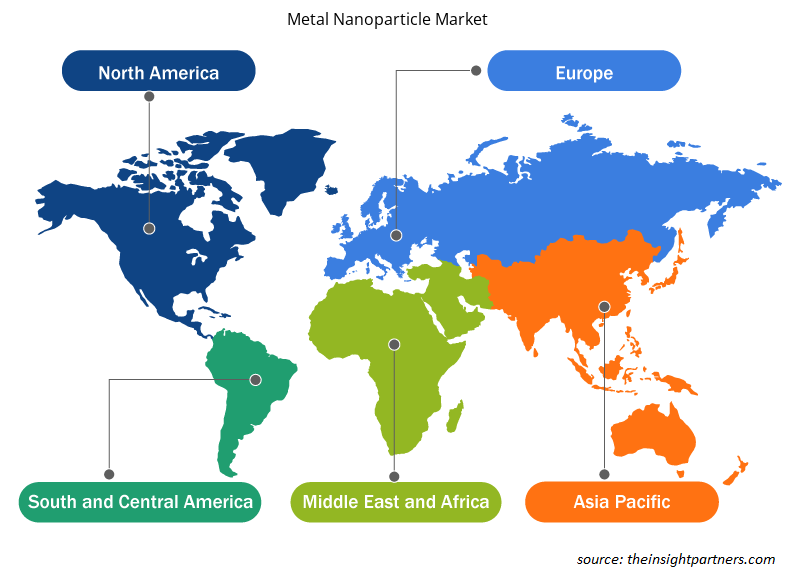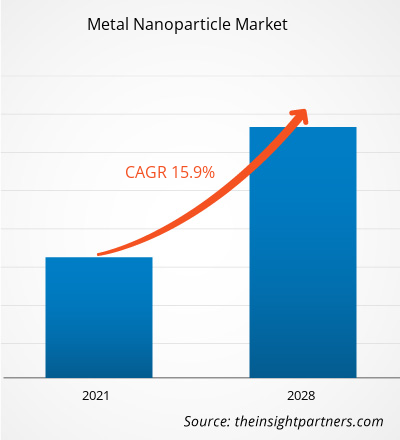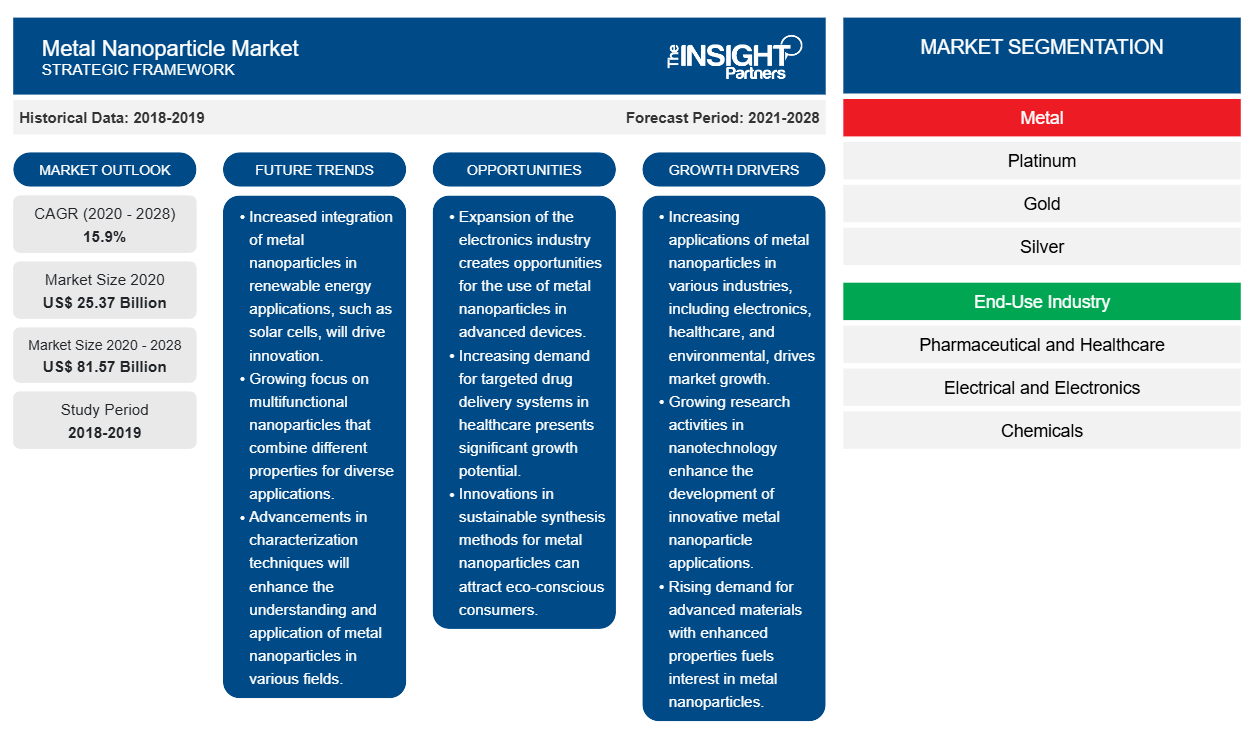[Rapporto di ricerca] Il mercato delle nanoparticelle metalliche è stato valutato a 25.373,92 milioni di dollari nel 2020 e si prevede che raggiungerà gli 81.567,38 milioni di dollari entro il 2028; si prevede che crescerà a un CAGR del 15,9% dal 2021 al 2028.
Le nanoparticelle metalliche hanno proprietà eccezionali come elevato aspect ratio e dimensioni uniformi. Sono utilizzate in un ampio spettro di applicazioni, come catalisi, medicina e stoccaggio di energia. Le nanoparticelle metalliche hanno varie applicazioni nei settori di utilizzo finale, come prodotti farmaceutici e sanitari, prodotti chimici, cosmetici, elettrici ed elettronici.
Nel 2020, il Nord America ha rappresentato la quota maggiore del mercato. L'aumento dello sviluppo dei settori farmaceutico e sanitario e un aumento della domanda di risorse energetiche sostenibili hanno aumentato la domanda di nanoparticelle metalliche nel Nord America. Grazie alla presenza di paesi sviluppati, come gli Stati Uniti e il Canada, e al favorevole supporto governativo per le attività di R&S, i paesi della regione esplorano e producono prodotti innovativi. Inoltre, i progressi nella tecnologia medica e i maggiori investimenti nel settore sanitario hanno spinto la domanda di nanoparticelle metalliche nell'industria medica. Insieme a questo, la presenza di aziende nazionali e internazionali di nanoparticelle metalliche nella regione ha creato opportunità redditizie per il mercato delle nanoparticelle metalliche nella regione.
L'attuale pandemia di COVID-19 ha avuto un impatto significativo sul mercato delle nanoparticelle metalliche. L'epidemia ha distorto l'efficienza operativa e interrotto le catene del valore a causa della chiusura improvvisa dei confini nazionali e internazionali, che ha creato perdite di fatturato e danni. Le interruzioni nella produzione e nella catena di fornitura hanno avuto un impatto negativo sul mercato delle nanoparticelle metalliche. L'implementazione del lockdown in vari paesi insieme alle restrizioni di viaggio ha ridotto la fornitura globale di prodotti insieme a una riduzione delle operazioni logistiche. Sono in corso ricerche per l'utilizzo di nanoparticelle d'oro per i kit di test COVID-19, che forniranno i risultati in pochi minuti. Negli Stati Uniti, un gruppo di ricercatori dell'Università del Maryland ha affermato di aver sviluppato un test diagnostico in grado di rilevare il nuovo coronavirus che causa COVID-19 entro 10 minuti e i risultati saranno visibili a occhio nudo. Il test è un semplice test basato sulla colorimetria, che utilizza nanoparticelle d'oro che sono ricoperte dalla sequenza di acidi nucleici della fosfoproteina del nucleocapside del virus SARS-COV-2. Insieme a questo, Sugentech, Inc. (una società nella Repubblica di Corea) ha sviluppato il kit di test SGTi-flex COVID-19 IgM/IgG, che è un kit di test immunocromatografico basato su nanoparticelle d'oro che determina gli anticorpi IgM e IgG del COVID-19. Il test aiuta a determinare gli anticorpi che sono proteine specifiche, che vengono sviluppate in risposta all'infezione. Pertanto, un maggiore utilizzo di nanoparticelle d'oro nel settore sanitario sta avendo un impatto positivo sul mercato delle nanoparticelle metalliche.
Personalizza questo report in base alle tue esigenze
Riceverai la personalizzazione gratuita di qualsiasi report, comprese parti di questo report, o analisi a livello nazionale, pacchetto dati Excel, oltre a usufruire di grandi offerte e sconti per start-up e università
-
Scopri le principali tendenze di mercato in questo rapporto.Questo campione GRATUITO includerà analisi di dati che spaziano dalle tendenze di mercato alle stime e alle previsioni.
Approfondimenti di mercato
Applicazione delle nanoparticelle metalliche nel settore medico
Nel settore medico, le nanoparticelle metalliche vengono sempre più utilizzate in agenti terapeutici, somministrazione di farmaci, bioimaging e diagnosi e trattamento del cancro, tra le altre applicazioni. Vari tipi di nanoparticelle metalliche, tra cui argento, titanio, oro, platino e rame, sono noti per i loro potenziali effetti terapeutici. Le nanoparticelle di oro e argento inibiscono efficacemente la crescita di batteri gram-negativi e gram-positivi. Le nanoparticelle di oro vengono utilizzate per rilevare biomarcatori nella diagnosi di malattie infettive, cancro e malattie cardiache. Le nanoparticelle di platino vengono utilizzate in applicazioni biomediche come impianti, imaging, terapia fototermica e somministrazione di farmaci grazie alle loro intrinseche proprietà antimicrobiche, antiossidanti e antitumorali. Le nanoparticelle di titanio vengono utilizzate per uccidere i batteri presenti su varie superfici. Quando esposte a radiazioni ultraviolette, queste nanoparticelle producono un forte effetto ossidativo e agiscono come disinfettanti fotocatalitici. Le nanoparticelle di argento hanno proprietà antimicrobiche e antitumorali e vengono sempre più utilizzate nella produzione di rivestimenti per ferite e rivestimenti per dispositivi. Le nanoparticelle di rame vengono utilizzate nel settore medico per la protezione, il controllo e il trattamento delle infezioni. Pertanto, un'impennata nell'applicazione di varie nanoparticelle metalliche nel settore medico sta guidando il mercato delle nanoparticelle metalliche.
Approfondimenti sui metalli
In base al metallo, il mercato delle nanoparticelle metalliche è segmentato in platino, oro, argento, ferro, titanio e altri. Nel 2020, il segmento degli altri ha dominato il mercato. Le altre nanoparticelle metalliche sono realizzate in metalli come zinco, rame, silice, manganese, alluminio, nichel, cerio e tallio. La nanoparticella di zinco è un ossido metallico inorganico e può essere utilizzata in sicurezza nei medicinali, come conservante negli imballaggi e come agente antimicrobico. Le nanoparticelle di zinco si diffondono facilmente nel materiale alimentare e uccidono il microbo. Le nanoparticelle di rame vengono prodotte tramite il processo naturale o tramite sintesi chimica. Sono sempre più utilizzate come agente colorante e agente antimicrobico. Le nanoparticelle di silice sono utilizzate principalmente negli isolanti elettrici e termici e nelle applicazioni di somministrazione di farmaci. Le nanoparticelle di manganese (nanodots o nanopolvere) sono particelle metalliche nanostrutturate, sferiche o sfaccettate, ad elevata superficie. Le nanoparticelle di alluminio hanno una maggiore capacità di immagazzinamento dell'idrogeno e sono ampiamente utilizzate negli aerei, nelle applicazioni militari, nelle automobili e nei propellenti per razzi.
Alcuni dei principali attori del mercato che operano nel mercato delle nanoparticelle metalliche sono American Elements; BBI Group; EPRUI Biotech Co. Ltd.; Meliorum Technologies, Inc.; Nanocomposix; Nanosc, Inc.; Nanostructured and Amorphous Materials, Inc.; Nanoshel LLC.; TANAKA HOLDINGS Co., Ltd.; e US Research Nanomaterials INC. I principali attori del mercato adottano strategie quali fusioni e acquisizioni e lanci di prodotti per espandere la presenza geografica e la base di consumatori.
Segnala i riflettori
- Tendenze progressive nel settore delle nanoparticelle metalliche per aiutare gli operatori a sviluppare strategie efficaci a lungo terminenanoparticles industry to help players develop effective long-term strategies
- Strategie di crescita aziendale adottate dalle aziende per garantire la crescita nei mercati sviluppati e in via di sviluppo
- Analisi quantitativa del mercato globale delle nanoparticelle metalliche dal 2019 al 2028nanoparticles market from 2019 to 2028
- Stima della domanda di nanoparticelle metalliche in vari settori industrialinanoparticles across various industries
- Analisi di Porter per illustrare l'efficacia degli acquirenti e dei fornitori che operano nel settore per prevedere la crescita del mercato
- Sviluppi recenti per comprendere lo scenario competitivo del mercato e la domanda di nanoparticelle metalliche
- Tendenze e prospettive di mercato, insieme ai fattori che guidano e frenano la crescita del mercato delle nanoparticelle metalliche
- Comprensione delle strategie che sostengono l'interesse commerciale in relazione alla crescita del mercato globale delle nanoparticelle metalliche, aiutando nel processo decisionale
- Dimensioni del mercato delle nanoparticelle metalliche in vari nodi del mercato
- Panoramica dettagliata e segmentazione del mercato globale delle nanoparticelle metalliche nonché delle dinamiche del settore
- Dimensioni del mercato delle nanoparticelle metalliche in varie regioni con promettenti opportunità di crescita
Nanoparticelle metalliche
Approfondimenti regionali sul mercato delle nanoparticelle metalliche
Le tendenze regionali e i fattori che influenzano il mercato delle nanoparticelle metalliche durante il periodo di previsione sono stati ampiamente spiegati dagli analisti di Insight Partners. Questa sezione discute anche i segmenti e la geografia del mercato delle nanoparticelle metalliche in Nord America, Europa, Asia Pacifico, Medio Oriente e Africa e America meridionale e centrale.

- Ottieni i dati specifici regionali per il mercato delle nanoparticelle metalliche
Ambito del rapporto sul mercato delle nanoparticelle metalliche
| Attributo del report | Dettagli |
|---|---|
| Dimensioni del mercato nel 2020 | 25,37 miliardi di dollari USA |
| Dimensioni del mercato entro il 2028 | 81,57 miliardi di dollari USA |
| CAGR globale (2020 - 2028) | 15,9% |
| Dati storici | 2018-2019 |
| Periodo di previsione | 2021-2028 |
| Segmenti coperti |
Di Metallo
|
| Regioni e Paesi coperti |
America del Nord
|
| Leader di mercato e profili aziendali chiave |
|
Densità degli attori del mercato delle nanoparticelle metalliche: comprendere il suo impatto sulle dinamiche aziendali
Il mercato delle nanoparticelle metalliche sta crescendo rapidamente, spinto dalla crescente domanda degli utenti finali dovuta a fattori quali l'evoluzione delle preferenze dei consumatori, i progressi tecnologici e una maggiore consapevolezza dei benefici del prodotto. Con l'aumento della domanda, le aziende stanno ampliando le loro offerte, innovando per soddisfare le esigenze dei consumatori e capitalizzando sulle tendenze emergenti, il che alimenta ulteriormente la crescita del mercato.
La densità degli operatori di mercato si riferisce alla distribuzione di aziende o società che operano in un particolare mercato o settore. Indica quanti concorrenti (operatori di mercato) sono presenti in un dato spazio di mercato in relazione alle sue dimensioni o al valore di mercato totale.
Le principali aziende che operano nel mercato delle nanoparticelle metalliche sono:
- Elementi americani
- Gruppo BBI
- Società anonima EPRUI Biotech Co. Ltd.
- Meliorum Technologies, Inc.
- Nanocomposito
Disclaimer : le aziende elencate sopra non sono classificate secondo un ordine particolare.

- Ottieni una panoramica dei principali attori del mercato delle nanoparticelle metalliche
Mercato delle nanoparticelle metalliche, per metallo
- Platino
- Oro
- Argento
- Ferro
- Titanio
- Altri
Mercato delle nanoparticelle metalliche, per applicazione
- Farmaceutica e Sanità
- Elettrico ed elettronico
- Prodotti chimici
- Cura della persona e cosmetici
- Altri
Profili aziendali
- Elementi americani
- Gruppo BBI
- Società anonima EPRUI Biotech Co. Ltd.
- Meliorum Technologies, Inc.
- Nanocomposito
- Nanosc, Inc.
- Materiali nanostrutturati e amorfi, Inc.
- Nanoshel LLC
- Società anonima TANAKA HOLDINGS Co., Ltd.
- Ricerca statunitense sui nanomateriali INC
- Analisi storica (2 anni), anno base, previsione (7 anni) con CAGR
- Analisi PEST e SWOT
- Valore/volume delle dimensioni del mercato - Globale, Regionale, Nazionale
- Industria e panorama competitivo
- Set di dati Excel
Report recenti
Rapporti correlati
Testimonianze
Motivo dell'acquisto
- Processo decisionale informato
- Comprensione delle dinamiche di mercato
- Analisi competitiva
- Analisi dei clienti
- Previsioni di mercato
- Mitigazione del rischio
- Pianificazione strategica
- Giustificazione degli investimenti
- Identificazione dei mercati emergenti
- Miglioramento delle strategie di marketing
- Aumento dell'efficienza operativa
- Allineamento alle tendenze normative























 Ottieni un campione gratuito per - Mercato delle nanoparticelle metalliche
Ottieni un campione gratuito per - Mercato delle nanoparticelle metalliche